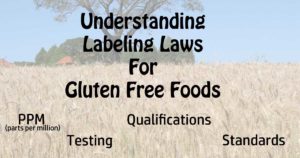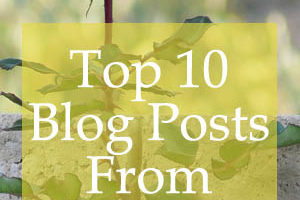The Food Allergen Labeling and Consumer Protection Act (FALCPA) went into effect in 2006. This law mandated that if a product contained any of the top 8 allergens: milk, eggs, fish, crustacean shellfish, peanuts, tree nuts, wheat and soy, then it had to be listed in the ingredients or in a contains statement.
It also mandated that these ingredients be listed plainly. So, in other words they couldn’t rename the ingredient so that it was hard to identify. They could call it by something else, but then need to put in parenthesis and explain what it is. Also, if any ingredient in the product contains a top 8 allergen it must be listed as well. For example: soy sauce (wheat). This rule only applies to the top 8 allergens and doesn’t include rye, barley or oats.
Watch out for barley, rye and oats
Did you know that the ingredient list on a label doesn’t have to be a complete ingredient list?! They can leave things out of the ingredients if they want! With this law they are required to at least list the top 8 allergens, no matter how small the amount of that ingredient might be, but only those 8 are required!
The culprit we run into the most, that isn’t listed on the label, with the ingredients is malt (barley). Barley is used as a flavoring, most frequently listed as malt, but they don’t even have to put that on the label. We don’t see rye as often and most oats are NOT safe in most products if you are gluten free!
Interesting information about barley from the Gluten Free Watchdog, Llc. https://www.glutenfreewatchdog.org/news/barley-at-one-time-a-controversial-grain-for-folks-with-celiac-disease/
Important note on oats
As long as oats meet the 20ppm or less rule they can be called gluten free. There is no “standard” test, or protocols to testing for gluten free safety. In fact, they don’t have to test if they don’t want to. However, if they label “gluten free” and the FDA tests, then they are supposed to get in trouble, but this isn’t happening.
There are no requirements for testing. This is one of the reasons there are so many problems with Cheerios! The best oats are those that follow a purity protocol.
Gluten Free Labeling Law
In 2014 the rules guiding what constituted an item as “gluten free” went into effect. Many say they would like to have 0 ppm for gluten free products. Keep in mind that this would mean very, very few products would qualify and accurate testing can only be done to 10 ppm.
20 ppm is the standard set by the FDA. This level was chosen because that is the level that has been adopted in Europe and Canada. Before the FDA set the 20 ppm there were NO rules as to what could be labeled gluten free! So, anything could be labeled gluten free!
*The labeling laws do NOT apply to supplements (vitamins, etc.)
FDA Rule
From the Food and Drug Administration they define “gluten free” as follows:
“In general, foods may be labeled “gluten-free” if they meet the definition and otherwise comply with the final rule’s requirements. More specifically, the final rule defines “gluten-free” as meaning that the food either is inherently gluten free; or does not contain an ingredient that is: 1) a gluten-containing grain (e.g., spelt wheat); 2) derived from a gluten-containing grain that has not been processed to remove gluten (e.g., wheat flour); or 3) derived from a gluten-containing grain that has been processed to remove gluten (e.g., wheat starch), if the use of that ingredient results in the presence of 20 parts per million (ppm) or more gluten in the food. Also, any unavoidable presence of gluten in the food must be less than 20 ppm.”
What does ppm mean?

For someone with celiac disease, it can take as little as 20 ppm to cause a reaction. That means, if this cookie were broken into a million pieces and if 20 or more of those pieces were gluten, it would cause a reaction! (Or if 2 or more of those cookies were eaten.)
“ppm” is the acronym for “parts per million”. This is a way of measuring a “pollutant” (or concentration) in a substance. So, in a gluten free labeled food product, out of one million parts, 20 of those parts can be gluten. Does that blow your mind?! One million is an enormous number and 20 is so small in comparison!
Now, you need to understand many people with celiac still get sick at 20 ppm! So, “a little bit won’t hurt you”, is far from the truth! What would happen if you are eating several products that contain 20 ppm or eating more than the suggested serving size? If one cookie contains 20 ppm then 2 would definitely make you sick!
The way I see it: if you don’t eat the suggested serving size or you eat several products at that 20 ppm, you are saturating your body with more gluten than it can handle. You risk having more than 20ppm in your body and having your body react to it! 20 ppm here and 20 ppm there adds up!
Labeled Gluten Free
Foods made with even, small amounts of gluten ingredients cannot be labeled gluten free! This includes hybrids like triticale, spelt, kamut, etc.
They can use the words “gluten free”, “without gluten”, or “no gluten” if their products meet the rules.
Hydrolyzed and Fermented
The rules regarding fermentation and hydrolyzed products are confusing. In one place, they say it doesn’t fit the rules if they start out with grains and ingredients that are already 20 ppm or less. Then, in another place they say, if it can be processed to be less than 20 ppm then it is okay. They also state that the testing of gluten once it is broken down isn’t developed to detect gluten in the smaller pieces and so the testing is highly unreliable! Their rules seem to contradict itself and leave the door open for interpretation, in an effort to include products that would meet these guidelines as well as many that don’t.
The recommendation and what is recognized by most gluten free and celiac groups is that fermented or hydrolyzed products are not safe for those who medically need to be gluten free! So, if the product started out with a gluten containing ingredient these two processes don’t make it safe! They should NOT be labeled gluten free!
Here’s what the Gluten Intolerance Group has to say about fermented and hydrolyzed foods. https://www.gluten.org/comment-on-the-fda-proposed-rule-for-gluten-free-labeling-of-fermented-or-hydrolyzed-foods/
Foods to avoid:
- Gluten removed beer
- Sour dough breads made with gluten containing ingredients
- Hydrolyzed soy sauces
- Oats that don’t follow a purity protocol
- Sourdough breads made from gluten containing grains
*not a complete list
Problems with the labeling rules
- The labeling rules/laws are all voluntary, including the testing of products.
- They can use whatever means they wish to measure the gluten. There isn’t a standard test they have to use and some may be less reliable than others.
- Not required to test for gluten in ingredients that go into the product, nor for the finished product.
- Not required to do ongoing tests for quality.
- FDA isn’t taking action against companies that break the rules and mislabel!
Mislabeled Products
Have you ever run across a product that says it is gluten free, but then in the ingredients or contains statement it says something about a gluten containing ingredient? These are not properly labeled and should NOT be labeled gluten free. If you find a product like this contact the FDA through MedWatch or the Consumer Complaint Coordinator in your area.
Even worse, is a product that contains gluten and doesn’t list all the ingredients on the label, making it a hidden gluten. If you suspect that a product may actually contain gluten call and ask for a complete list of ingredients in the product.
(Not every reaction is from gluten. Many people find other sensitivities and allergies after going gluten free.)
Comments Needed-Action
This petition done by Tricia Thompson of the Gluten Free Watchdog, Llc is petitioning the government to take action against companies who break the rules and don’t follow the FDA guidelines for gluten free food product labeling. The FDA needs to enforce the standards and requirements they have put in place! What good is a rule or requirement if there are no consequences when those rules are broken and requirements not followed?!
More you can do
If you ever have a question about a products ingredients call or e-mail the company and ask for a full list of ingredients. Ask if the product contains any gluten ingredients in any form. You may need to list them, because the person you contact may not know what all of the gluten ingredients are. Especially, when it comes to the derivatives of gluten grains (kamut, triticale, spelt, etc.) and malt, malt extract, and malt flavoring which all come from barley.
Certified Gluten Free Products
I love that there are groups like the Gluten Intolerance Group who certify and regularly test products! Their products are 10 ppm or less! You can find a list of certified gluten free products at https://www.gluten.org/resources/find-products/
Another, thing I love about the Gluten Intolerance Group’s certification is that they require on-going testing to assure compliance and quality control!
I feel confident knowing I can safely consume products with their certification!

This is the symbol you want to look for from the GFCO! I know I can trust products with this symbol!
Disclosure:
I am a branch manager of a local support group through the Gluten Intolerance Group. However, the things that I have written in this post are my own opinions and not those of the Gluten Intolerance Group. My blog is in no way compensated or related to the Gluten Intolerance Group and is completely my own.









5 Comments
Leave your reply.